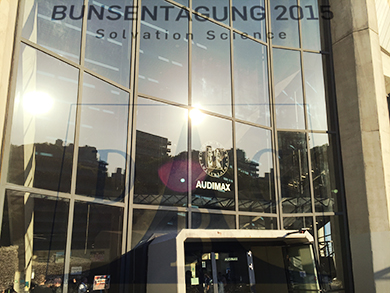The Bunsentagung is the annual meeting for physical chemistry in Germany organized by the Deutsche Bunsen-Gesellschaft für physikalische Chemie e.V. (DBG, German Bunsen Society for Physical Chemistry) and a local team. This year it was held at the Ruhr University Bochum (RUB) from May 14 to 16.
At the conference, all areas of physical chemistry were represented in approx. 113 oral presentations and over 300 posters. Around 650 international scientists attended the event.
This year’s main topic was solvation science. This emerging topic is seen as a cross-disciplinary field as, for example, materials sciences. Whereas solvents so far have been considered as inert media for different molecular processes, they are increasingly being seen as active species in solvent-mediated, solvent-controlled and solvent-driven processes. This is also due to the improved methods, especially in computational sciences. Current research focusses on microsolvation and hydration processes as well as the complex interplay of solutes and solvents.
Opening Ceremony
The meeting started with the Opening Ceremony, which was led by the first Chairman of the DBG, Professor Joachim Sauer, Humboldt University of Berlin, Germany. It was held in the Audimax of the RUB, which is also often used for concerts and houses the largest concert organ in North Rhine-Westphalia, the Klais organ. The organist Dr. Christian Vorbeck played several pieces on this organ including the overture of Händel’s Water Music to relate to the conference’s main topic, solvation science.
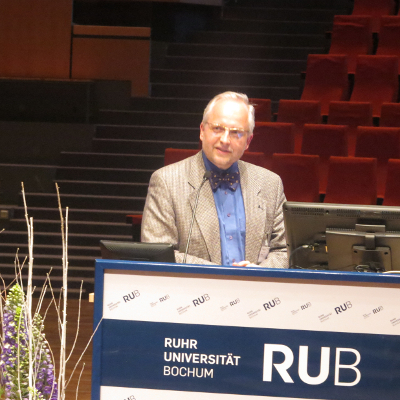 |
.jpg) |
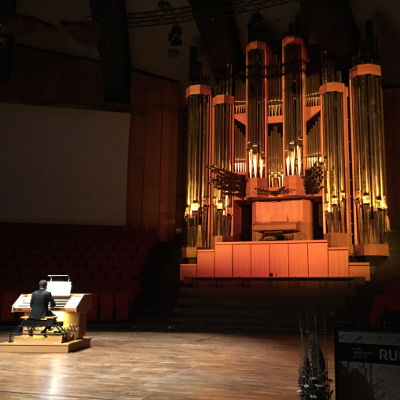 |
||
|
Welcome addresses from Professor Dominik Marx, core local organizer and director of the Center for Theoretical Chemistry, RUB, and Professor Elmar Weiler, rector of the RUB. |
Dr. Christian Vorbeck at the Klais Organ. |
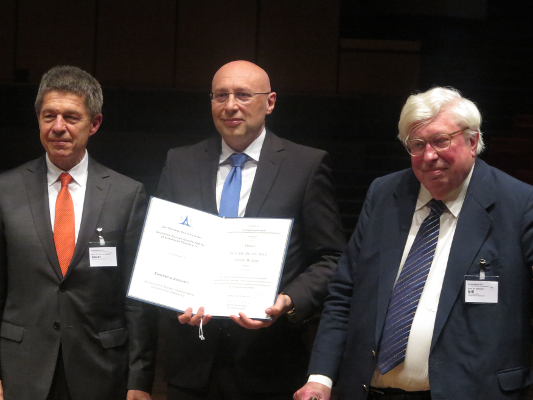 |
During the ceremony, Professor Stefan Hell, Max-Planck-Institut für Biophysikalische Chemie, Göttingen, Germany, was awarded a honorary membership of the DBG in recognition of his outstanding scientific achievements, in particular the development of ultra-high-resolution fluorescent microscopy and its use in biophysical chemistry. Since 1894, the DBG has given only 55 honorary memberships to persons who have developed a new idea or a new method. Stefan Hell has done both. Professor Gerhard Ertl, Chemistry Nobel Laureate, held a brilliant laudatio. |
|
|
(from left to right) Professor Joachim Sauer, Professor Stefan Hell, Professor Gerhard Ertl. |
The work of three outstanding scientists was also honored during the ceremony:
Professor Hans-Joachim Freund, Fritz Haber Institute of the Max Planck Society, Berlin, Germany, has been awarded the Bunsen Medal for his work in the field of surface chemistry and surface physics, as well as his contributions to the understanding of nanostructures for catalysis. (more)
Professor Christoph Bräuchle, University of Munich, Germany, has been awarded the Walther Nernst Medal for his contributions to applied physical chemistry, especially concerning fluorescence spectroscopy for the investigation of dynamic processes in cells. (more)
The Ewald Wicke Prize is given to scientists younger than 35. Professor Sereina Riniker, ETH Zurich, Switzerland, has been awarded this year’s prize in honor of her outstanding work in the field of method development for simulations of biological and chemical systems. (more)
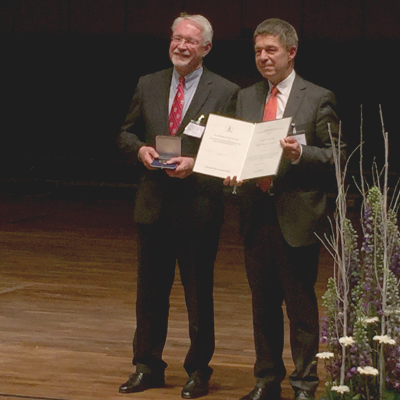 |
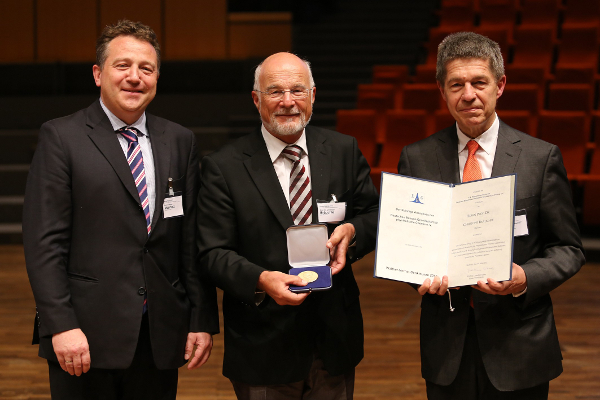 |
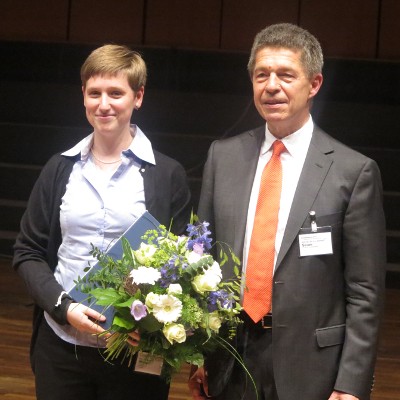 |
||
|
Professor Hans-Joachim Freund (left) with the Bunsen Medal, Professor Joachim Sauer (right). |
Professor Klaus Meerholz, University of Cologne (left), Professor Christoph Bräuchle (middle, laudatio), Professor Joachim Sauer (right). (Photo: © Lutz Leitmann/Deutsche Bunsen-Gesellschaft) |
Ewald Wicke Prize Winner Professor Sereina Riniker (left) and Professor Joachim Sauer (right). |
Public Opening Lecture
The 2014 Chemistry Nobel Laureate Stefan Hell very visually explained, in a talk open to the general public, how he has bypassed the long presumed limitation of optical microscopy. According to Abbe’s law, no better resolution than half the wavelength of light could be obtained.
In Hell’s stimulated emission depletion (STED) microscopy method, fluorescent molecules are stimulated with a laser to an excited state which can be detected by the microscope. With a second laser beam he de-exitates most molecules again so that they cannot be detected. By this, he can “pick” single molecules to be detected. 2.4 nm at λ = 775 nm was the best resolution so far. By using multiple states, absorption, or scattering, Hell hopes to further improve the technique.
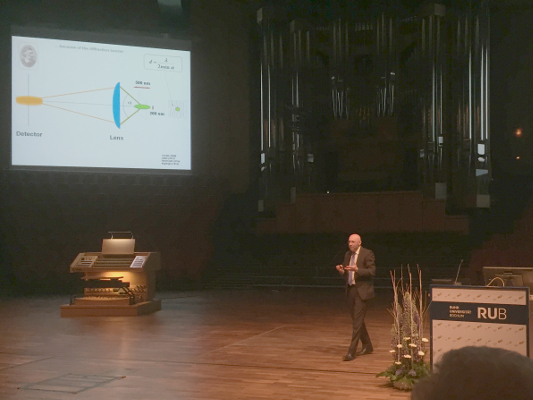 |
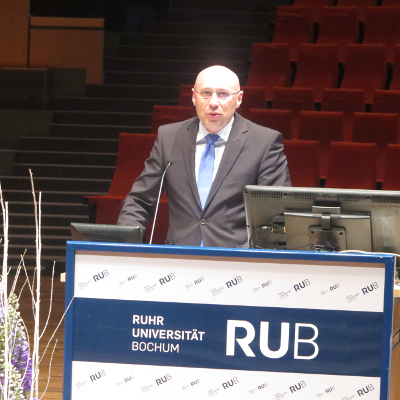 |
|
|
2014 Chemistry Nobel Laureate Professor Stefan Hell during his talk. |
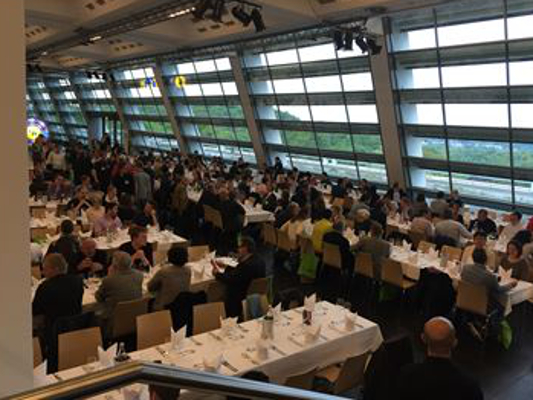 |
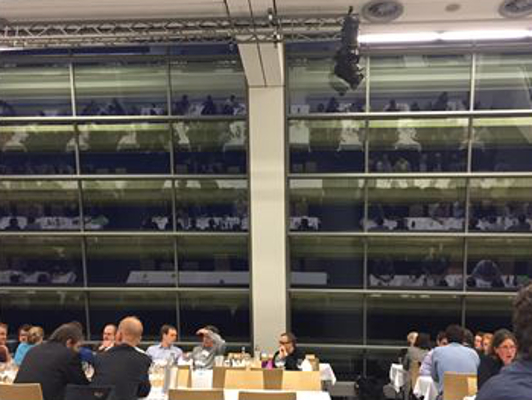 |
|
|
Welcome Dinner in the RUB mensa. |
Plenary Lectures
Professor Mark Johnson, Yale University, New Haven, CT, USA, talked about bottom-up aspects of solvation in spectroscopy and chemistry. His group uses, for example, temperature-controlled vibrational predissociation spectroscopy and looks at the equilibrium structures of hydration shells around molecular ions and contact ion pairs. They identified, e.g., the proton defect in protonated water clusters (H+(H2O)n, ≤ n = 28) using its spectral signature. Another intriguing example using vibrational signatures is the molecular-level mechanism of salt “dissolution”: during hydration of MgSO4 ion clusters, the ternary core ions experience a solvent-mediated deformation. When two water molecules reside in the first hydration shell of an iodide ion, they found that the dissociation enthalpy of the water/water bonds falls by about a factor of three relative to that of the isolated water dimer.
Professor Damien Laage, École normale supérieure, Paris, France, discussed the modelling of the dynamics and biochemical role of protein hydration shells. He pointed out that the reorientation dynamics of water next to proteins is moderately slower than in the bulk. When an enzyme in an apolar solvent is progressively hydrated, the protein flexibility increases. But no lubrication effect is found for the chemical step in the catalysis. The increased enzymatic activity upon hydration is suggested to result from a non-reactive substrate conformation that becomes destabilized. These ideas are currently applied to design new strategies to enhance the enzymatic activity in non-aqueous solutions.
The role of water in bioprocesses was the topic of the talk of Professor Irit Sagi, Weizman Institute of Science, Rehovot, Israel. She uses integrated X-ray and Terahertz (THz)-based time resolution to look at protein-water network dynamics during metalloenzyme hydrolysis. She analysed, for example, matrix metallo-proteines (MMPs), a group of human enzymes that play an important role in tissue remodelling and are linked to cancer and autoimmune diseases. She found that MMPs showed retarded hydration dynamic behavior at the metal catalytic site during collagene catalysis. Additionally, she used X-ray absorption spectroscopy (XAS) and a hydration dynamics approach to design and screen small molecule allosteric inhibitors for metallo-enzyme homologes. Currently, Sagi is implementing XAS kinetic THz absorption (KITA) experiments in drug design.
Professor Angelos Michaelides, Thomas Young Centre, University College London (UCL), UK, talked about his recent work on modelling water/solid interfaces, which are poorly understood at the molecular level. Together with his team, he found that novel structures can form even on simple flat metal surfaces, so that traditional ice rules do not apply to describe the bonding. For some systems, nuclear quantum effects have a big impact, especially for proton transfer. For the most they are small and can be neglected. Due to differences in the free energy, water shows very different friction on graphene and hexagonal boron nitride (h-BN) despite their similar structure.
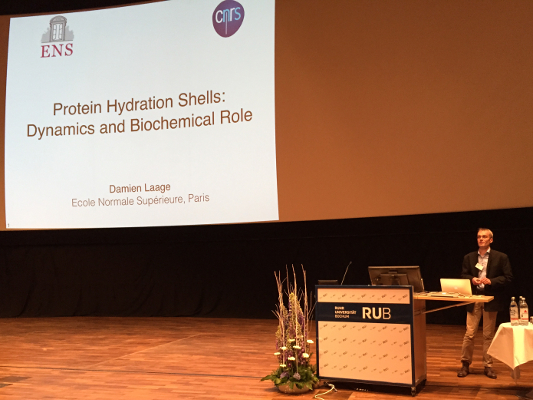 |
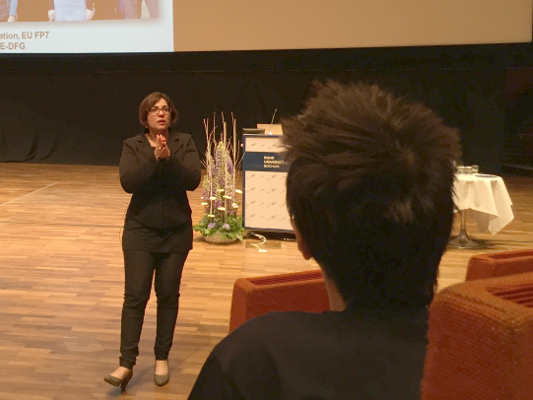 |
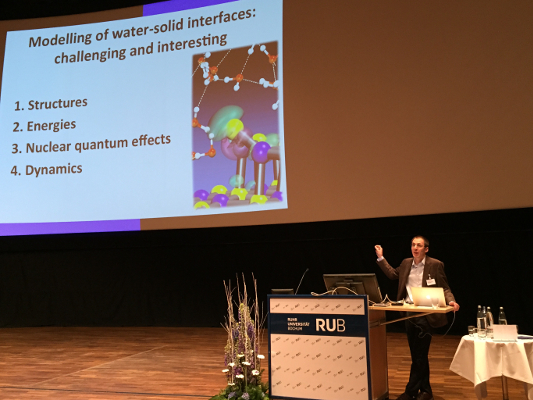 |
||
|
Professor Damien Laage (left), Professor Irit Sagi (middle), and Professor Angelos Michaelides (right) during their talks. |
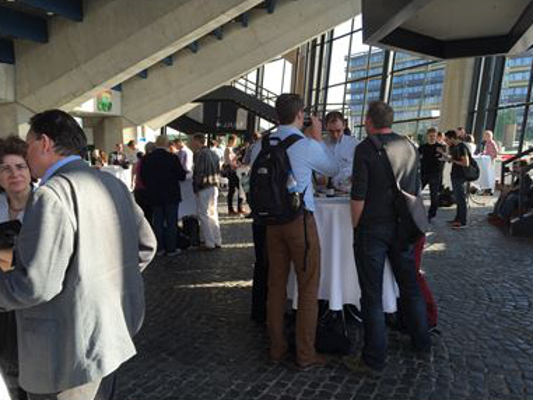 |
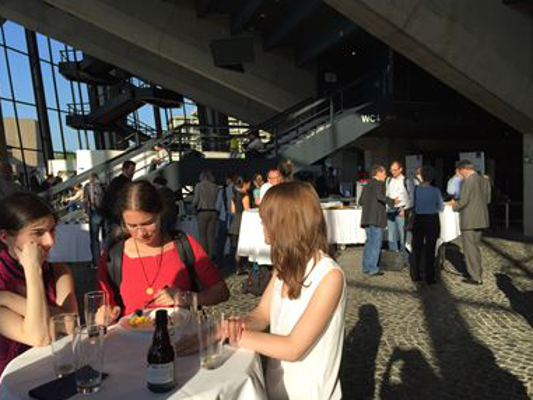 |
|
|
During the Poster Dinner. |
115th Bunsentagung
Next year the 115th Bunsentagung will take place in Rostock, Germany, from May 5 to 7, 2016, focusing on basic mechanisms for energy conversions. It will be organized by Professor Ralf Ludwig.
- Event: 114th Bunsentagung, University of Bochum, Germany
- News: Ewald Wicke Prize for Sereina Riniker
- News: Walther Nernst Medal Awarded to Christoph Bräuchle
- News: Bunsen Medal 2015
- Event Highlight: 113th Bunsentagung
Also of interest
- Video: Nobel Prize in Chemistry 2014 – Lecture by S. Hell
The video shows a lecture by Stephan Hell on Super-Resolution: Overview and Stimulated Emission Depletion (STED) Microscopy. - Walther Nernst and the Development of Physical Chemistry,
Gerhard Ertl,
Angew. Chem. Int. Ed. 2015, 54(20), 5828–5835.
DOI: 10.1002/anie.201408793
